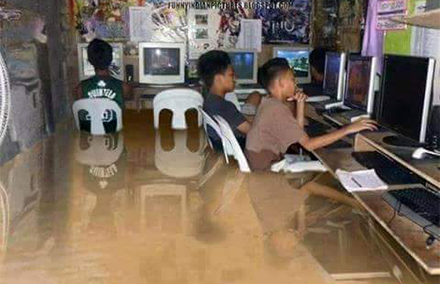
ANU PhD scholar Chit Win looks at the confluence of social media and natural disaster in Myanmar.
Myanmar is currently facing a flood unmatched by any other recent natural disaster in terms of the size of the affected area.
Half the country is flooded and four States have been declared natural disaster zones. According to the United Nations, 260,000 people are affected with 69 deaths and over 400,000 hectares of farmland inundated.
As dams and reservoirs started to overflow the situation worsened, making this the most devastating catastrophe since Cyclone Nargis, which wiped out the Ayeyarwady delta in 2008.
And Myanmar is now facing another flood; a massive flow of information about the disaster on social media.
When President Obama visited Myanmar during the 2014 ASEAN Summit, he remarked that everyone was holding smartphones. He’s not far off. These tiny devices with so much potential are reshaping Myanmar almost as much as the country’s incredible political and economic transformation.
Today, when forced to flee to higher ground, people in Myanmar’s flooded areas are leaving all their worldly possessions behind; except their smart phones. They cling to these devices for dear life.
Thanks to recent improvements in Myanmar’s telecommunications infrastructure, countless thousands of people are now posting photos, stark and eye-catching imagery of the flood, to Facebook. For many it is perhaps the only way of relieving their trauma. And while the flood worsens, the social media flood only intensifies.
As we all know, social media provides an incredibly powerful platform, which has helped reshape our world deeply, dramatically and in double-quick time. It’s no different with this disaster. While international media has largely only aired very brief reports about Myanmar’s flood, Facebook users are able to witness the situation unfold almost in real time. As photos are uploaded, expressions of sympathy, comments and criticisms come in tidal waves.
For example, people in Kalay, the worst affected area in Sagaing Region, complained about the lack of warning from authorities when water from the reservoirs overflowed and water levels quickly rose. Facebook users also ridiculed the military in Rakhine State when its helicopter dropped desperately needed rice bags into muddy water, making them inedible.
But the government also has a chance to respond to criticism through social media.
The helicopter pilot who dropped the rice bags responded emotionally about the dilemma of balancing the overweight helicopter and the desperate flood victims approaching him en mass. He had to make a calculated risk of distributing other essentials, such as instant noodles and water, by foregoing the rice bags.
Social media has also enabled Myanmar’s citizens to help flood victims.
With little confidence in the government’s ability to handle the crisis, people have started to take matters into their own hands. We are now seeing a steady flow of aid from well-wishers both within Myanmar and overseas. And while the international community is still assessing whether to get involved, Facebook users have already witnessed a rickshaw driver donating a day’s income, showing the true generosity of the Myanmar people.
On the flip side, there is no doubt that social media has also helped create panic. People used it to warn each other about the flood. Many of these warnings were rumors based on false information and misinterpretation, especially about the condition of the dams and reservoirs. However, social media not only meant these rumors quickly spread, but helped create pools of experts and forums for the exchange of expert information, as posts from meteorologists and dam experts provided much needed technical advice. Rumor made way for remedy.
Spurred on by social media, some officials have taken matters into their own hands. For example, there were posts that a dam in Magway Region was about to burst, with warnings that people should run for their lives. But people got confused and were unsure how they should act. They couldn’t leave their cattle behind, which is the lifeblood of Myanmar’s agricultural sector. Clearly, the local authorities had lost their influence when it came to sharing critical information.
But a local junior official from the Irrigation Department came up with a brilliant idea. He stayed up all night at the dam constantly uploading posts about its condition, declaring that he would remain there until the dam burst. He is now a Facebook celebrity with 22,000 followers.
Overall, the social media flood amid Myanmar’s actual flood shows the nature of the country’s transition. During Cyclone Nargis we knew very little and were told very late about the situation and how the disaster was being handled. This time the flood is being covered minute-by-minute via social media and we can see how authorities have responded, for better or for worse.
At the same time, Myanmar’s authorities also have a chance to observe the situation through Facebook. While they battle with the flood, they also encounter another front in the social media surge, tackling rumors and trolls as people remain connected and online even in times of crisis.
People may not listen to the special radio broadcasts on the flood situation, but they read people’s posts and they feel proud when they receive a “like” for their own. But unlike this natural disaster, which can’t end soon enough, we see no signs of Myanmar’s social media flood receding anytime soon.
Chit Win is a PhD student in the Coral Bell School for Asia Pacific Affairs at the ANU College of Asia and the Pacific, and the President of the ANU Myanmar Students’ Association (ANUMSA).
ANUMSA is raising money for Myanmar’s rescue and rehabilitation efforts. As part of these efforts it is hosting an event at ANU on Monday, 10 August. For more details on how to donate see here. Details of the event are here.
 Facebook
Facebook  Twitter
Twitter  Soundcloud
Soundcloud  Youtube
Youtube  Rss
Rss 